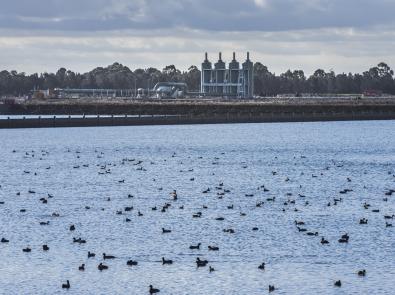Hundreds of different bird species – some rare and endangered – can be spotted at our Western Treatment Plant, as well as along Melbourne’s waterways and wetlands.
Whether you’re a beginner birdwatcher or experienced ‘twitcher’, discover key species and where to find them, including if you need to apply for birdwatching access to our sites.
Western Treatment Plant birdwatching
One of Victoria’s most popular birdwatching sites, Werribee’s Western Treatment Plant welcomes birds from as far away as Siberia.
The plant’s lagoons, grasslands and coastline provide an ideal and varied habitat – offering a permanent water supply, plenty of food, and little interference from humans. Much of the surrounding areas have been recognised as a wetland of international significance under the Ramsar Convention.
Birdwatching access
You must have approval to birdwatch at the Western Treatment Plant.
Find out about applying for access and site access conditions, or what you might see while you’re there:
Bird species at the Western Treatment Plant
Other birdwatching locations
Eastern Treatment Plant
The Eastern Treatment Plant is home to a large native bird population, including many species of regional, state and national significance.
The plant provides habitat for large numbers of migratory waders, which arrive around August and leave for the northern hemisphere between February and May. Some travel up to 24,000 kilometres a year.
Birdlife Australia organises monthly bird surveys, typically held every fourth Sunday from 9am until early evening. Numbers are restricted and booking is essential – so keep an eye on their events calendar.
Volunteer with Birdlife Australia
Edithvale-Seaford Wetland
At any one time, up to 7,000 birds are estimated to reside at the Edithvale-Seaford Wetland – the largest remaining natural wetland of its kind in Greater Melbourne.
The wetland is circled by an extensive walking and cycling trail with elevated viewing platforms. On the weekends the Friends of Edithvale-Seaford Wetlands staff a nearby bird hide with excellent views of the wetland, which schools can learn more about by booking a visit to our nearby Education Centre.
You do not need a permit to birdwatch at the wetland.
Edithvale-Seaford Wetland Education Centre
Friends of Edithvale-Seaford Wetlands
Local rivers and creeks
Melbourne’s rivers and creeks offer 25,000 kilometres of opportunities for spotting our feathered friends. Get to know your river and its inhabitants – download a wildlife guide on the following pages:
You may also like...
An independent, not-for-profit bird conservation organisation aiming to create a bright future for Australia’s birds.







